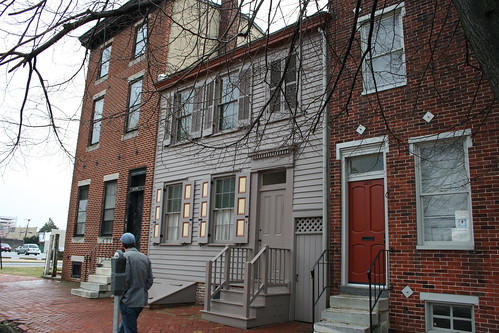This summer has found me thinking a lot more about the basic concept of our course: Whitman and place. “Place” to me is emerging not just as the streets of Fredericksburg and DC, though that is powerful, but also as a place in time or history–where is Whitman now, here? My ideas about it are fluid and exist more as a series of juxtaposed experiences and images, which I will call paratactic catalogue rather than jumbled thoughts. On the Fourth and Fifth, these elements were part of my catalogue:
a parade moves through the streets of Fredericksburg, where George Washington walked and his mother Mary lived, where George Washington Whitman would have marched uphill (determined? afraid? moving between the staggering Union survivors in retreat?) and come back down (marching? dragging? on a stretcher?–exhausted, defeated, wounded, through the blood of thousands dead in a day);
my family and others march behind an election banner for our neighbor, the Commonwealth Attorney for the city: La Bravia Jenkins, an African American woman;
the cluster of African American friends, family, and supporters for La Bravia are the only people of color I see in the parade, which is a collection of children on decorated bikes, babies in strollers and wagons, the cow from Chik-fil-a, one clown;
my son walks in the parade wearing a paper George Washington mask and a tricorn hat, above his red-and-white Obama 2008 t-shirt, calling “Happy Independence Day!” to the people on the sidewalks;
I mull over the fact that the parade is called The Heritage Parade;
at the dunking booth for the Fredericksburg street festival, my son waits nearly an hour for the editor of the local paper to get in so he can pitch the balls and dunk him in chilly water for the conservative viewpoints he spouts from the editorial page;
at Montpelier, the home of James Madison, Architect of the Constitution, which sits about 50 minutes south of Fredericksburg and was used for a winter encampment of Confederate soldiers in 1863 when Whitman was two hours north in DC, we read about Madison’s death in the words of his literate “man-servant,” who reports that just before he died, Madison told his niece it was “nothing but a change of mind”;
in the basement of the home, the cellars, storage rooms to which Dolley Madison kept the keys, and indoor kitchens, which are not on the guided tour, we see the first names of 120 slaves written in cursive letters on transparent plastic informational signs throughout the rooms, their ghostly naming floating behind facts and dates;
we read that one of Madison’s slaves accompanied him to Philadelphia, where he listened to Madison, a man always well prepared for his debates, defend freedom and basic rights for all human beings and then challenged his master about slavery; Madison admired his thinking and could not deny his point, so he wrote to his father that the slave would not be fit for plantation life again and might incite unrest among the other slaves; after the Congress he was sold in Pennsylvania, a state where he might earn his freedom after seven years of servitude;
we find that one of Madison’s oldest and longest serving slaves was named Moses; my partner says, “Ironic”;
we cross wet grass barefoot to see some headstones partially hidden by trees, and find they are for race horses because the Montpelier estate houses a stable for retired thoroughbred racers, which was established by the enormously wealthy DuPont family that purchased the house and land several years after Dolley’s death in poverty;
the slave cemetary we walk to has no headstones at all, just indentations in the earth where the soil has given way to rotting coffins– about five visible though there must be 100; the sign shows a photo of the indentations filled with snow, which increases their visibility;
we see that Dolley Madison lived long enough to be photographed, her likeness hanging next to her husband’s oil painting in a small gallery;
a fraction of a letter handwritten by Madison is also on display, having been found by historic preservationists in a mouse nest inside the walls of Montpelier in the last ten years and later authenticated by experts.
History/heritage/legacy/preservation/tradition. Race. Economy. Politics. War. Literacy/language. My Whitman Catalogue for Independence Day.



